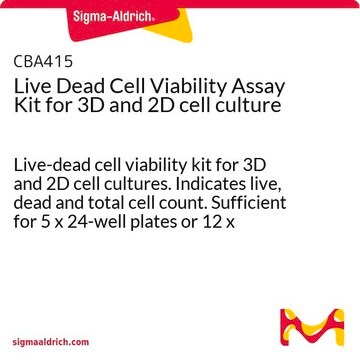CBA411
EZMTT High Sensitivity Cell Viability Assay, 50X
A novel tetrazolium salt based viability and proliferation assay for continous monitoring of growth in low density mammalian and bacterial cell culture.
Synonym(e):
Cell viability assay kit
Größe auswählen
334,00 €
Voraussichtliches Versanddatum30. Mai 2025
Größe auswählen
About This Item
334,00 €
Voraussichtliches Versanddatum30. Mai 2025
Empfohlene Produkte
Nachweisverfahren
colorimetric
Allgemeine Beschreibung
Traditional tetrazolium salts, such as MTT, react with NAD(P)H-dependent cellular oxidoreductase enzymes to produce an insoluble formazan, which requires solubilization and have lower sensitivity. Moreover, they cannot reliably detect cell viability in low density cultures, such as primary cell cultures.
EZMTT viability assay solution is based on a novel monosulfonated tetrazolium salt, 2-(3-(2-methoxy-4-nitrophenyl)-2-(4-nitrophenyl)-2H-tetrazol-3-ium-5-yl) benzenesulfonate sodium salt (EZMTT). The EZMTT reagents provided high quality and reproducible detection for oxidoreductase enzymes, indicators of cellular metabolic activity. Upon reacting with metabolic enzymes, EZMTT is converted to a yellowish formazan that does not require solubilization step and can be measured by absorbance at 450 nm. EZMTT assay can be used to measure cell viability and cytotoxicity (loss of viable cells), or cytostatic activity (shift from proliferation to quiescence) of potential medicinal or toxic agents.
<bold>Features and Benefits of EZMTT:</bold>
• EZMTT solution can be premixed with any media and buffer and added directly to the cells.
• EZMTT is very sensitive and can be used to detect metabolic activity of low-density or suspension cell cultures.
• Reduction of EZMTT produces a water-soluble yellow formazan dye, which does not require solubilization step
• Can be used for end-point viability assay of mammalian as well as bacterial cells
• Much less reactive with other antioxidants such as beta-Mercaptoethanol (BME)
• More sensitive than the traditional MTT assays
Assay Protocol for titration:
1. Detach cells and seed different cell number (0, 1000, 2000, 5000, 10000) in each well of 96-well plate with 10% FBS DMEM in triplicates.
2. Incubate at 37?C, 5% CO? for 3-4 hours or overnight.
3. Then change the culture medium with 100 μl of 10% FBS DMEM (optional).
4. Thaw and Mix EZMTT cell viability assay solution with culture media (10X dilute).
5. Add 10X EZMTT solution to each well of the plate (final 1Xdilute).
6. Incubate the plate for 1-4 hours in the incubator.
Measure the absorbance at 450 nm using a microplate reader.
Assay Protocol for toxicity studies:
1. Detach cells and seed cell number (1000) in well (1-11 columns) of 96-well plate with 10% FBS DMEM in triplicates.
2. Incubate at 37?C, 5% CO? for 3-4 hours. Then add compounds (e.g. final 0-30 μg/ml, 2 fold dilutions) and incubated for 3-5 days.
3. Then change the culture medium with 100 μl of 10% FBS DMEM. (optional)
4. Thaw and Mix EZMTT TM cell viability assay solution with culture media (10X dilute).
5. Add 10X EZMTT TM solution to each well of the plate (final 1Xdilute).
6. Incubate the plate for 1-4 hours in the incubator.
Measure the absorbance at 450 nm using a microplate reader.
Lagerung und Haltbarkeit
Haftungsausschluss
Lagerklassenschlüssel
10 - Combustible liquids
WGK
WGK 2
Flammpunkt (°F)
188.6 °F - (refers to pure substance)
Flammpunkt (°C)
87 °C - (refers to pure substance)
Analysenzertifikate (COA)
Suchen Sie nach Analysenzertifikate (COA), indem Sie die Lot-/Chargennummer des Produkts eingeben. Lot- und Chargennummern sind auf dem Produktetikett hinter den Wörtern ‘Lot’ oder ‘Batch’ (Lot oder Charge) zu finden.
Besitzen Sie dieses Produkt bereits?
In der Dokumentenbibliothek finden Sie die Dokumentation zu den Produkten, die Sie kürzlich erworben haben.
Protokolle
Learn how to perform cell migration assays in vitro using Millicell® hanging cell culture inserts and the suspension T-cell lines Jurkat and primary CD4+ cells. Monitor migration by flow cytometry and EZ-MTT assays.
Aktive Filter
Unser Team von Wissenschaftlern verfügt über Erfahrung in allen Forschungsbereichen einschließlich Life Science, Materialwissenschaften, chemischer Synthese, Chromatographie, Analytik und vielen mehr..
Setzen Sie sich mit dem technischen Dienst in Verbindung.






